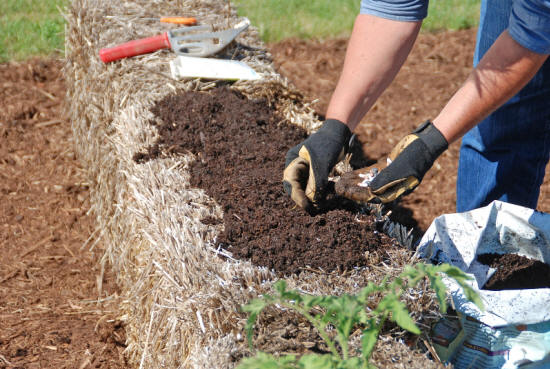|
 Create
a Garden Anywhere with Straw Bales Create
a Garden Anywhere with Straw Bales
By Melinda Myers
 Send a link to a friend
Send a link to a friend
[April 29, 2016]
Add
productive garden space and raise your planting bed with straw bale
gardening. This technique allows gardeners to create raised bed
gardens on a patio, lawn or any area with poor compacted soil. Straw
bale gardening has been around for centuries, but thanks to Joel
Karsten’s book “Straw Bale Gardens” it has gained new popularity. |
|
 All that is needed are a few straw bales, fertilizer, a bit of
compost and time to condition, plant and water the garden. All that is needed are a few straw bales, fertilizer, a bit of
compost and time to condition, plant and water the garden.
Be sure to purchase straw bales made from alfalfa, wheat, oats, rye
or other cereal grain that have less weed seeds than hay. Start a
few weeks before the designated planting date.
Place the bales in their permanent location with the cut sides up
and twine parallel to the ground. Once you start the condition
process, the bales will be very heavy and hard to move. When the
bales are in place you are ready to start the conditioning process.
This is done to start the inside of the straw bales composting, so
they’ll support plant growth.
On day one, spread fertilizer over the top of the bale. Use a ½ cup
of a complete garden fertilizer or three cups of an organic
fertilizer like Milorganite (milorganite.com). Then completely
moisten the bale. The organic fertilizers feed the microorganisms
that help decompose the straw into a nutrient rich planting medium.
 Thoroughly soak the bale everyday. On days three and five you will
add more fertilizer at the same rate used on day one.
Days seven through nine use half the rate used on day one. This
would be ¼ cup of a complete garden fertilizer or 1 ½ cups of an
organic fertilizer. Thoroughly water the bale each time.
On day ten you will add one cup of 10-10-10 or three cups of an
organic fertilizer rich in phosphorous and potassium. This completes
the conditioning process.
Bales treated with a complete fertilizer should be ready to plant.
You may need to wait a few more days when using an organic
fertilizer. The inside of the bale should be the temperature of warm
bath water or cooler for planting. If it is hotter than this, wait
for the bale to cool a bit before you plant. [to top of second
column] |

Use a trowel to pry open a hole in the bale. Place the plant in the hole and
cover the roots with potting mix or compost.
Create a planting bed for seeds by covering the bale with a one- to two-inch
thick layer of planting mix. Follow the planting directions on the back of the
seed packet.
Regular watering is critical for success with this method. Soaker hoses or drip
irrigation make this an easier task. You can also use gallon milk jugs with
holes in the bottom or inverted two-liter soda bottles placed near the base of
each plant to provide water where it is needed.
Give your straw bale garden a nutrient boost about once a month or as needed
throughout the growing season.
Follow these steps and you’ll be well on your way to growing a productive straw
bale garden to enjoy throughout the season.
[By Melinda Myers]
Gardening expert Melinda Myers has more
than 30 years of horticulture experience and has written over 20
gardening books, including Small Space Gardening and the Midwest
Gardener’s Handbook. She hosts The Great Courses “How to Grow
Anything: Food Gardening For Everyone” DVD set and the nationally
syndicated Melinda’s Garden Moment TV & radio segments. Myers is a
columnist and contributing editor for Birds & Blooms magazine and
spokesperson for Milorganite. Myers’ website is
www.melindamyers.com.
 |